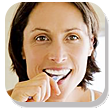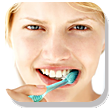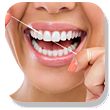Prevention is the key to great oral health. Better diet, medical care, and other factors are allowing us to live longer lives. Unfortunately, our teeth have not adapted to our longer life span and need help to last as long as we do. To make your teeth last a lifetime proper dental care is a must.

Adhering to the suggested time intervals for your dental cleaning appointments is crucial. During these appointments we examine your gums for early signs of periodontal disease. While we clean your teeth, we note areas where it may be difficult for you to remove plaque and locate areas of gum tissue inflammation and measure your gum tissue for signs of periodontal disease. We will then demonstrate effective oral self-care to prevent these areas from progressing into periodontal disease.
We want to stress prevention. Don’t wait for the warning signs of gum disease to occur before you schedule your dental hygiene appointment. If you have very few fillings, have not lost any permanent teeth (other than wisdom teeth), and have very thorough oral self-care daily, a yearly cleaning and exam by the dental hygienist and dentist may be adequate. If you have had a great deal of dental work performed (bridges, crowns, fillings) or if you have missing teeth it may be necessary for more frequent dental office visits. We will let you know what is appropriate for your individual oral condition.
Watch video to learn about health risks related to poor oral hygiene.

An old humorous expression says, “You don’t have to brush all your teeth every day. Only the ones you want to keep!” And while we laugh at these words, the message could not be more correct. To maintain good oral health, teeth must be thoroughly cleaned each and every day. One good method of brushing is called the modified Bass technique. It is easy and quite effective. We can instruct you on how to brush properly. It is certainly easier to see it done than to read and imagine. But this will help you get started.
Use a multi tufted, soft, nylon-bristled toothbrush. Hard-bristled toothbrushes can easily damage your teeth and gums. Soft-bristled toothbrushes last about 3 months before they need to be replaced. Don’t keep a toothbrush for an extended period of time. When the toothbrush bristles become worn, they will not give you the best possible performance. Medium and hard brushes will last longer, but almost everyone brushes too hard to use these brushes. If you use medium and hard brushes or brush improperly with any toothbrush, you can cause permanent damage to your gum tissue, causing it to wear away. This can also wear notches into the tooth itself, exposing the dentin. In both cases, severe tooth sensitivity could develop.
The bristles of the brush should be angled toward the area where the tooth meets the gum, approximately a 45-degree angle.
The bristles of the brush should be able to gently slide under the gum tissue. Gently move the brush back and forth so that there is a vibrating motion, not a scrubbing motion. The brush head should be able to cover and clean about two teeth at a time.
Brush each area for about 10 seconds, and then roll the bristles to the biting surface. Move the brush head so that it overlaps a small portion of the tooth just brushed and the next teeth. Repeat until all teeth are brushed.
Brush all teeth. Start on the cheek side of the back teeth, at one corner of your mouth, brushing as you move across to the opposite corner. Then switch to the inside (tongue or palate side) and again brush from one corner to the other. Brush both upper and lower teeth using the vibrating back-and-forth motion.
Some areas will require you to switch the brush to a different angle such as the inside (tongue and palate side) of the top and bottom front teeth. Using the tip or small end of the brush will help brush around this curved area. Use the same type of vibrating motion with the brush, moving up and down against the tooth.
Brushing the biting surfaces of the teeth is easy. Place the bristles on the biting surface of the teeth into the grooves and brush back and forth. Be sure to brush the biting surfaces of left side and right side, upper and lower teeth.

Start with a 14- to 16-inch piece of floss. Any type of floss is okay to use. Non shredding is easiest to use. It’s thinner and most people find it easier to use. Lightly wrap the floss around the forefingers of each hand until there is a length of about 1 to 1.5 inches available between the fingers. Don’t wrap it so tightly that you cut off circulation and your fingers turn blue! Using your thumbs and forefingers, position the floss over the spot where two teeth meet. With a gentle buffing motion, back and forth, move the floss between the teeth and slide it first under the gum around one of the teeth in a U shape. Move the floss up and down a few times, then reverse the U and floss the other tooth. The floss needs to get under the gum. Then remove the floss and place it between the next two teeth. Holding the floss taunt between your fingers will give you more control, and flossing will be easier.
When you are able to perform these daily procedures effectively, you will significantly reduce your risk of gum disease and decay, and the associated expenses of treatment. There are other flossing aids available if you have problems using your hands. Let us know about these problems. Electric or mechanical toothbrushes can also be used. Again, talk to us about these devices. Keeping your teeth healthy for the rest of your life can be accomplished one day at a time.
Copyright © Aldrich Dental. All rights reserved. | Legal Notes | Privacy Policy